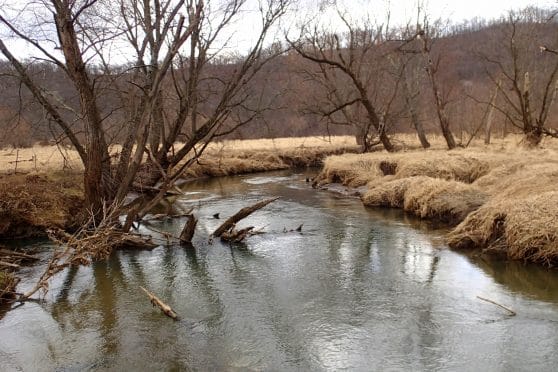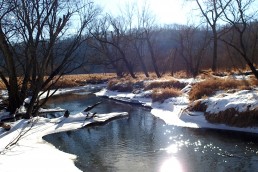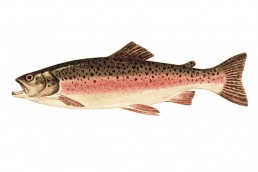Trout Angling 101: Planning Your Season
SHARE THIS POST
Chasing the wily small-stream brown trout requires much more thinking than the average spectator thinks. Bowhunting is the only outdoor pursuit that requires more planning and considerations. Seasons change. So should your approach to chasing trout.
Summer has its hurdles to get over. Weeds make many areas unfishable. Walking through chest-high weeds is like fishing and doing aerobics at the same time. The edge of the stream is very hard to distinguish. Landing a trout there is a real nightmare. Look for livestock in this time of the year to manicure your stream for you and make your fishing experience more fruitful.
Look for springs and small feeders. Seems like a small, insignificant feature. But, that small trickle is the best indicator of potential browns. Trout need dissolved oxygen in the water to breathe. Small feeders are typically a constant temperature and have much more dissolved oxygen in the water in the dog days of summer. Also, browns like a stream temperature of around 60 degrees. Small feeder streams are the keys, especially during summer. Browns could be lying almost anywhere. One hundred yards away from the feeder stream, that could not be said.
Spring trout angling
 Spring has a whole different set of rules. Springs in the drifless run between 40 to 42 degrees year-round. The trout will congregate downstream of the feeder in the slower water. Logs in the water will be good current breaks. The trout will be attracted to the current breaks. They don’t have to swim and fin to hold in place there. Trout try to minimize their movement during cold weather because it requires burning calories to swim to hold in place. They will come out of the shelter of their hides to take a large meal but will move back to their shelters straight way. Small appetizers are ignored when the water is colder. Trout are looking for a main course, this time of year. Reward versus energy expended is key during these days. The smaller the meal, the smaller the trout during these days.
Spring has a whole different set of rules. Springs in the drifless run between 40 to 42 degrees year-round. The trout will congregate downstream of the feeder in the slower water. Logs in the water will be good current breaks. The trout will be attracted to the current breaks. They don’t have to swim and fin to hold in place there. Trout try to minimize their movement during cold weather because it requires burning calories to swim to hold in place. They will come out of the shelter of their hides to take a large meal but will move back to their shelters straight way. Small appetizers are ignored when the water is colder. Trout are looking for a main course, this time of year. Reward versus energy expended is key during these days. The smaller the meal, the smaller the trout during these days.
Are you enjoying this post?
You can be among the first to get the latest info on where to go, what to use and how to use it!
Fishing the opener
January opener, again, has a whole new set of rules. Your smaller feeder streams are the only reason there is any open water during this time of the year. Just upstream of a feeder, I cannot take a stream temperature due to the stream being iced over. Your feeder stream is a magnet to the browns of this stream in this time of the year. I like to call it the Bahamas Effect. Any current at all this time of the year is a no go. They will not lay in current. Their bodies cannot process enough calories to allow it. They will ignore tiny appetizers, this time of year. Big lures/flies are the only thing they will even move for. When I say move, I mean slower than any other time of the year.
The bright sunlight during winter also complicates the success of the angler. The leaves are gone and the sun truly complicates things. Trout do not have eyelids and shun sunlight. This time of the year, slow is paramount. Deep, slow water below feeders or “thermals” are the ticket.
Rules are not written in stone. You may catch a big trout with a small offering during cold conditions, but your success rate with larger meals makes your “big” rate go up significantly. If you drop a small offering on their heads and it requires little movement to eat it, they will. The reason you are catching mostly “smalls” during extreme weather is you are throwing small stuff.
In extreme conditions of cold and hot, it is important to get your catch in quickly. Size up your gear and get them to hand quickly so they will not die in the mandatory catch-and-release areas. I have had large trout come in like wet socks during the heat of summer and the bitter winter cold. Please release your trout quickly after they are revived during these times.
MWO
SHARE THIS POST
Did you enjoy this post?
You can be among the first to get the latest info on where to go, what to use and how to use it!
Len Harris
Len Harris lives in the heart of the Wisconsin driftless area. He fishes for anything that has fins. His first love is small stream trout fishing, with northern pike fishing a close second. Harris writes for many local papers and has written two books that are available on Amazon.



